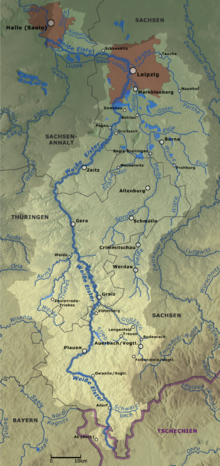White Elster
You can help expand this article with text translated from the corresponding article in German. (November 2022) Click [show] for important translation instructions.
|
| White Elster Weiße Elster, Bílý Halštrov | |
|---|---|
 White Elster valley near Wünschendorf/Elster | |
 | |
| Location | |
| Countries | |
| Physical characteristics | |
| Source | |
| • location | Hazlov, Karlovy Vary Region, Czech Republic |
| • elevation | 724 m (2,375 ft) |
| Mouth | |
• location | Saale |
• coordinates | 51°25′57″N 11°57′10″E / 51.43250°N 11.95278°E |
| Length | 257 km (160 mi) |
| Basin features | |
| Progression | Saale→ Elbe→ North Sea |
| Tributaries | |
| • left | Weida |
| • right | Schwarzbach, Trieb, Göltzsch, Schnauder, Pleiße, Parthe, Reide |
The White Elster[1][2][3] (German: Weiße Elster, Czech: Bílý Halštrov) is a 257-kilometre (160 mi) long river in central Europe, right tributary of the Saale. Its source is in the westernmost part of the Czech Republic, in the territory of Hazlov. After a few kilometres, it flows into eastern Germany where it cuts through the Vogtland in (according to the Encyclopædia Britannica) a "deep and picturesque valley".[4] In Germany it flows through the states of Saxony, Thuringia and Saxony-Anhalt. The White Elster flows through the cities of Plauen, Greiz, Gera, Zeitz, Pegau and Leipzig, and into the river Saale in Halle.
Name
Although "Elster" is German for "magpie", the origin of the name has nothing to do with the bird. It is of Slavic origin: alstrawa = hurrying water. The White Elster never meets the Black Elster, which flows from Lusatia into the River Elbe. The rivers have the names "white" and "black" to distinguish between them.
History
The White Elster proved disastrous to the French troops when they retreated from Leipzig in October 1813, as a part of the Napoleonic Wars.[2] Józef Poniatowski, Marshal of France, drowned in the river on 19 October 1813.
-
Source of the White Elster
See also
References
- ^ The "White Elster" river at www.germany-tourism.co.uk
- ^ a b Brookes, Richard and Marshall, John (1832). A new universal gazetteer: containing a description of the principal nations, W.W. Reed & Co,, New York, p. 270
- ^ White Elster from National Geospatial-Intelligence Agency, Bethesda, MD, USA. Accessed on 16 Jan 2011.
- ^ Chisholm, Hugh, ed. (1911). . Encyclopædia Britannica. Vol. 9 (11th ed.). Cambridge University Press. p. 300.
- White Elster
- Rivers of the Karlovy Vary Region
- Cheb District
- Rivers of Saxony
- Rivers of Saxony-Anhalt
- Rivers of Thuringia
- White Elster basin
- Rivers of Germany
- International rivers of Europe
- Saxony river stubs
- Thuringia river stubs
- Saxony-Anhalt river stubs
- Karlovy Vary Region geography stubs
- Czech Republic river stubs

